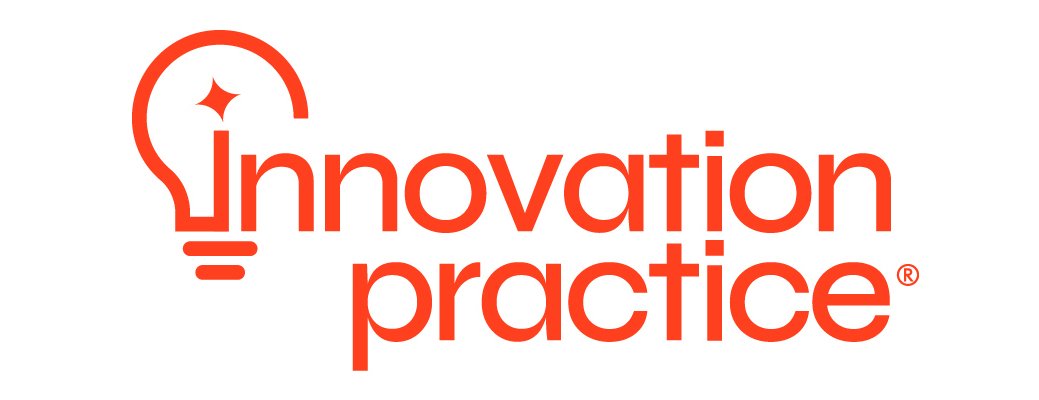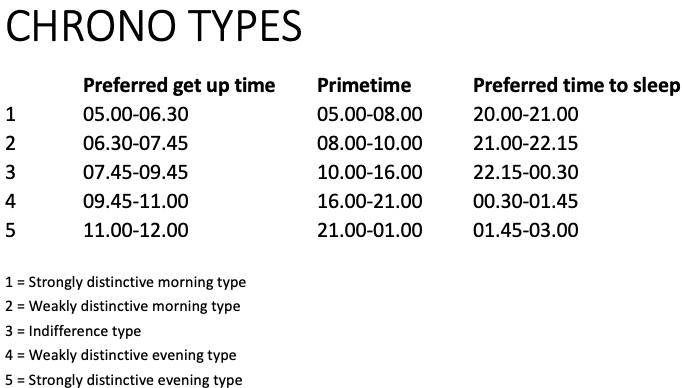Know Your Chronotype
We are all born different, in many important ways. One of them is our internal clock. A person's chronotype is their propensity to sleep at a particular time during a 24-hour period: it affects when they want to get up in the morning, and when they are ready to hit the pillow at night.
What does our chronotype have to do with creativity? If you want to maximize your deep work and be effective in your creative practice, you need to work in sync with your chronotype.
Prime time is a short window when our energy levels are highest and you are most primed to focus on demanding tasks. This can lead to what Cal Newport calls deep work: “Professional activity performed in a state of distraction-free concentration that push your cognitive capabilities to their limit. These efforts create new value, improve your skill, and are hard to replicate.” This is also time when you are most likely to experience flow. For distinctly morning types, prime time is between 5am and 8am; for distinct evening types, that is between 9pm and 1am.
Source: Inquiry into chrono types, Ostberg
Prime time is the time when it is best to focus on converging. Focusing on one thing and going deep. There is a myth that we need a lot of time (like 6-hour blocks) to create something new. And when we don’t have that luxury of time, most of us don’t even try to work on complex and demanding tasks. In reality, our prime time is usually much shorter — only around 90 minutes — and if you can block that time in your calendar a few days each week, you can create incredible progress. Guard this time like a tiger!
Creative act is a combination of diverging and converging and our mind is primed for each sort of thinking at different times of the day. So there is another window of time worth guarding, it is the time when your brain is primed for diverging, the practice of making novel connections.
Knowing your chronotype can help you build your creative practice.
Creative work can not happen on demand, and rarely yields to short bursts between meetings (Paul Graham has written about this phenomenon in Maker’s Schedule, Manager’s Schedule) . This is why many artists, scientists and other prolific individuals cultivate a very strict and regular routine — as Charles Dickens once said, “I never could have done what I have done without the habits of punctuality, order, and diligence, without the determination to concentrate myself on one subject at a time.” A closely guarded schedule allows them to show up for themselves and do their work when they’re at their peak.
The peak for creative work does not always mean higher energy. Low times are times when we experience fall in energy levels like for example after lunch, late in the afternoon and just before sleep. These times are supposed to be best for creative thinking, like for example generating new ideas, connecting the dots in unexpected ways, getting inspired by something unrelated to the problem we are solving. Setting aside time to think during low energy times can be a good way to train your mind to relax and start putting together connections that could turn into ideas.
What prevents a lot of us from productively using our time is that we are not blocking windows of time for diverging and converging in alignment with our inner clock. While prime time is great for converging, low times might be best suited for diverging.
The other thing that prevents us from making progress on complex projects is that we expect to sit down and immediately produce amazing work. And when on day 1, 2, and sometimes 10 we only have shitty drafts, we give up. As Ann Lamott says “Almost all good writing begins with terrible first efforts. You need to start somewhere. Start by getting something—anything—down on paper. What I've learned to do when I sit down to work on a shitty first draft is to quiet the voices in my head.” Pushing and perusing through low quality work — knowing that it’s only from a high volume of work that great work will emerge — will help us continue showing up day after day.
Lastly, it’s important to note that our brain needs time to transition into flow. Most prolific people have a starting ritual that leads into prime time in order to condition their brain for what is coming. Some examples: Igor Stravinsky played the same fugue by Bach every morning. Choreographer Twyla Tharp wakes up at dawn and hail a taxi to her studio for a workout every single day. Consider designing a ritual that will alert your brain that prime time is approaching.
Knowing your prime time and low time is important. But what really matters is showing up for yourself and your work. Creativity is a craft that gets honed through deliberate practice, and we need to show up for that practice. Every single day. Some days it is very easy, inspiration is flowing and we can’t wait to start working. On other days it is hard, almost frustrating. But being committed to still do the work is key. As my yoga teacher Adriene Mishler says, “Show up on your mat! Every day.”

